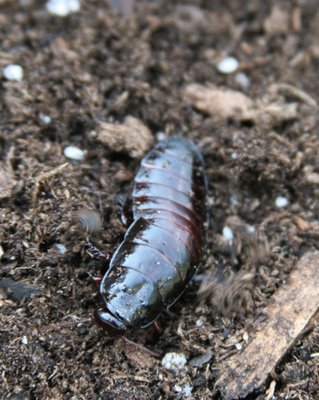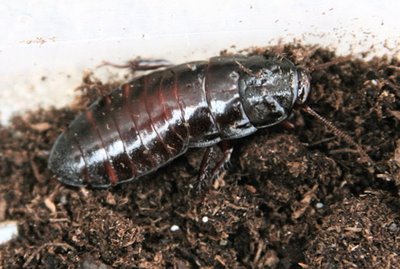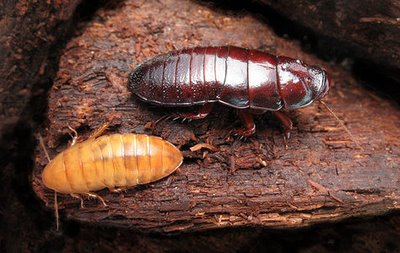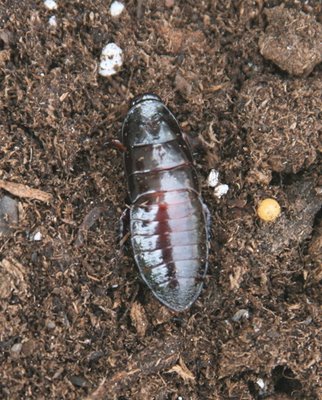 I noticed first that its cerci, the two antenna-like projections at the tip of the abdomen that are one of the roach family's distinguishing characteristics, were very small, but still present. Its legs were heavily barbed, strong and stout. It looked like a miniature version of the Madagascar hissing cockroaches I used to visit in their plastic shoeboxes in the Harvard Biolabs. I knew that I had seen this bug before, but only in a photograph. A photograph in my brand-spankin' new Kaufman Field Guide to Insects of North America.
I noticed first that its cerci, the two antenna-like projections at the tip of the abdomen that are one of the roach family's distinguishing characteristics, were very small, but still present. Its legs were heavily barbed, strong and stout. It looked like a miniature version of the Madagascar hissing cockroaches I used to visit in their plastic shoeboxes in the Harvard Biolabs. I knew that I had seen this bug before, but only in a photograph. A photograph in my brand-spankin' new Kaufman Field Guide to Insects of North America.Oh! Oh! Oh! Mad scramble for the book. And there it was, the brown-hooded cockroach, right there on the roach page where I remembered it being. But there, too, in one tantalizing paragraph, was its story. The hair stood up on my legs (which took some doing, since I'd just shaved 'em) when I read this:
The Brown-hooded Cockroach (Cryptocercus punctulatus), often placed in its own family (Cryptocercidae), is a unique social insect of northwestern mountains and the Appalachians. It lives in family groups in rotting wood, females giving live birth to three or four offspring. These nymphs feed on adult feces, consuming protozoans that help digest cellulose. They take six years to mature.
So we've got a native insect, an endemic, almost, with a disjunct range. Which gives live birth, instead of laying a gross little egg capsule like most roaches that infest houses. Whose offspring live on the feces of their parents. Which is social. A social roach. Which takes Six Years to Mature. It was almost too much to take in at one time.

I did a little digging around on the Net. From discoverlife.org came the following synopsis, which differs in some details from the Eaton/Kaufman story:
Wood roaches are monogamous and exhibit considerable parental care: a mated pair stay together for several years and raise a single set of offspring. After a sexually mature wood roach finds a mate (how? I don't know), the pair establishes a nesting site in a dead log on the forest floor. They will probably stay in one log for the rest of their lives. Wood roaches have ecological and physiological similarities to their close relatives, the termites. Like termites, they feed on dead wood and live in galleries they construct within fallen logs. Since insects lack the enzyme cellulase, they rely on microbes to digest wood. Termites and wood roaches house these microbes, primarily flagellated protozoa, in their gut. The mated female lays a clutch of 50-100 eggs. A newly hatched roach nymph's gut is empty - it does not have any symbiotic microbes. To get these from its mother or father it uses proctodeal trophallaxis (feeding on fluids from the adult's anus). The necessity of obtaining gut microbes is a constraint on the life history of the wood roach: these insects cannot grow to maturity as loners. Initially the nymphs feed exclusively by trophallaxis and are completely dependent on their parents for their nutrients. As they mature, they acquire their own gut flora and begin feeding on dead wood directly. Development to sexual maturity takes more than two years.
Here's a roach and its nymph, a picture taken off the Net. Vastly superior to mine. I found this insect a bit tough to photograph, since being out in the light upset it and it made endless circles around the perimeter of its enclosure. This is a jolly good shot, even though it's lifted.

So. Do they lay eggs or give birth to live young? Dunno. Does it take two or six years to reach sexual maturity? Dunno that, either. See how much we don't know for sure about insects? When it comes right down to it, they are unknown, weird piled on weird.
Cryptocercus. Hidden cerci. Yeah. Punctulatus would mean spotted. In the words of Tom Morrison, the foreman of the construction crew that built our birding tower, I was "all ate up." I jumped up and down, pumping my fists like Tiger Woods after a birdie. High-fiving Bill. New Bug! Weird Social Long-Lived Bug! In our House! Still am all ate up, to have this venerable Appalachian social cockroach circling around in a plastic pitcher on my kitchen counter. But none of that could have happened unless Kenn Kaufman and Eric Eaton and my beloved publisher, Houghton Mifflin (Harcourt), had gotten it together to make this brand-new field guide to insects, this gift to the planet, to Science Chimps everywhere. Get yourself one at your local bookstore, or order it online. Give yourself the gift of knowing your roaches, your stink bugs, your odd long-horned beetles, your Midas flies and scorpion flies. Let your curiosity rule the day. Tune in to the previously inaccessible world of insects.

I let it go the next day in rotting wood, of course. Hoping there would be a new social group of brown-hooded cockroaches for it to join. What it was doing in the bedroom I can't imagine. As Bill said, "I'm just glad I didn't flush it."






1 comments:
Julie,
I stumbled across your blog as I was surfing the net to identify a roach I saw in our woods yesterday--this is it!
And appropriate, too, that I should find it on your site. Janet Lee is a close friend of mine, and she's talked highly of you for most of the 10 years I've known her. I hear you on NPR sometimes, and get a warm fuzzy feeling knowing your once-removed connection to me. Thanks for the awesome blog!
eva
Post a Comment